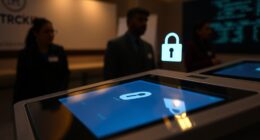Enroll in the Ethical Hacking: Sniffers Course to master detecting and defending against network sniffing threats. Learn to efficiently monitor network traffic, identify potential attacks, and safeguard vulnerable protocols such as Telnet, HTTP, and FTP. Understand essential sniffing techniques like ARP poisoning and MAC attacks, while implementing detection methods such as protocol analyzers and Intrusion Detection Systems (IDS) for real-time protection. Strengthen defenses by educating employees on risks and employing encryption protocols like VPN or SSL/TLS. By embracing this course, you'll acquire crucial skills to secure your network against potential threats.
Key Takeaways
- Utilize intrusion detection systems for real-time alerts on potential sniffing attacks.
- Educate employees on sniffing risks and prevention strategies to enhance network security.
- Implement encryption protocols like VPN or SSL/TLS to secure data transmission.
- Regularly monitor network traffic for anomalies using protocol analyzers.
- Employ a combination of detection techniques for robust defense against sniffing threats.
Course Overview
The 'Course Overview' section provides a detailed introduction to the Ethical Hacking: Sniffers Course. This course explores the world of network sniffing, with a focus on detecting and defending against potential threats.
Students will learn how to effectively monitor network traffic, identifying any signs of sniffing attacks that may compromise network security. The curriculum covers various protocols vulnerable to sniffing, including Telnet, HTTP, and FTP, offering learners a thorough understanding of potential weaknesses.
Moreover, the course offers insight into both passive and active sniffing techniques. Passive sniffing involves monitoring network traffic without altering it, while active sniffing involves more direct interaction with the network to capture data.
Sniffing Techniques
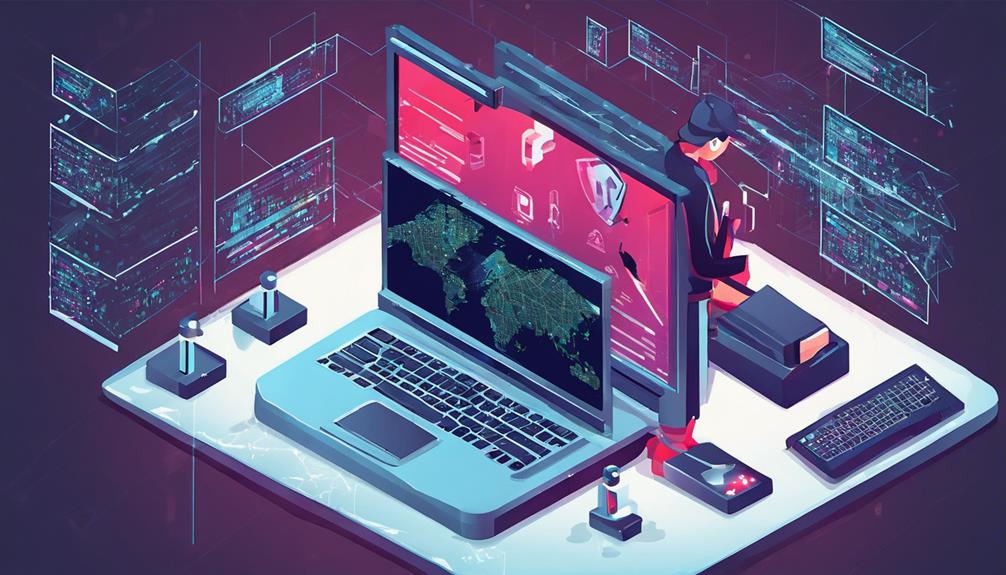
Sniffing techniques encompass a range of strategies for monitoring network traffic. Understanding the basics, such as packet capture methods and the usage of specialized tools, is essential for ethical hackers looking to secure their systems.
Sniffing Basics
When monitoring network traffic to capture data packets, ethical hackers employ various sniffing techniques to identify vulnerabilities and enhance cybersecurity measures. Sniffing basics involve the interception of data packets as they traverse a network, presenting a range of security threats. Techniques like ARP poisoning and MAC attacks exploit weaknesses in network protocols, allowing sniffers to intercept sensitive information easily.
To understand the key concepts of sniffing basics, let's explore the following table:
| Sniffing Technique | Description | Vulnerabilities Targeted |
|---|---|---|
| ARP Poisoning | Manipulates ARP cache tables | Address Resolution |
| MAC Attack | Floods network with fake MAC addresses | Media Access Control |
| Passive Sniffing | Monitors network without altering traffic | Data interception |
| Active Sniffing | Proactively injects data into the network | Traffic manipulation |
These techniques highlight the diverse methods employed by ethical hackers to detect weaknesses and fortify network security against potential threats. By understanding sniffing basics, cybersecurity professionals can effectively safeguard networks from malicious exploitation.
Packet Capture Methods
Utilizing various packet capture methods is essential in the domain of ethical hacking. It allows professionals to intercept and analyze data packets for security assessment and vulnerability identification.
Packet sniffing is a common technique in network security. It involves the interception of data packets as they travel across networks. This method enables hackers to access sensitive information transmitted over protocols like Telnet, HTTP, POP, IMAP, SMTP, and FTP.
This makes it vital for organizations to safeguard against potential attacks.
Sniffing Tool Usage
Using specialized software tools plays an essential role in the implementation of effective sniffing techniques for network security analysis and vulnerability assessment. Packet sniffers, a common type of sniffing tool, are necessary for intercepting and analyzing network traffic. These tools enable cybersecurity professionals to detect various types of attacks, such as man-in-the-middle attacks and password sniffing, by capturing and inspecting data packets.
By monitoring protocols like Telnet, HTTP, POP, IMAP, SMTP, and FTP, packet sniffers can identify vulnerabilities that malicious actors may exploit.
Sniffing at the data link layer allows for discreet monitoring of network activities, making it important for detecting unauthorized access and data leakage. Additionally, NIC cards operating in promiscuous mode are often used to listen to network data for sniffing purposes.
Sniffers play a critical role in identifying and addressing network vulnerabilities, as they exploit weaknesses in protocols to gain sensitive information from network traffic. Understanding the capabilities and limitations of sniffing tools and techniques is essential for effective network security management and defense against potential cyber threats.
Detection Methods

One key aspect of safeguarding networks against sniffing attacks involves employing effective detection methods. These methods include monitoring network traffic for any unusual or suspicious activities that may indicate the presence of a sniffer.
Implementing encryption protocols is another vital step in protecting data from being intercepted by potential sniffers, as encrypted data is much harder to decipher. Additionally, organizations can utilize Intrusion Detection Systems (IDS) to detect and alert them to potential sniffing attempts in real-time, allowing for immediate action to be taken.
Regularly monitoring network traffic with protocol analyzers can also aid in the identification of any malicious activities that could be indicative of a sniffing attack. Educating employees on the risks associated with sniffing attacks and how to prevent them is essential for enhancing detection capabilities within an organization.
Prevention Strategies
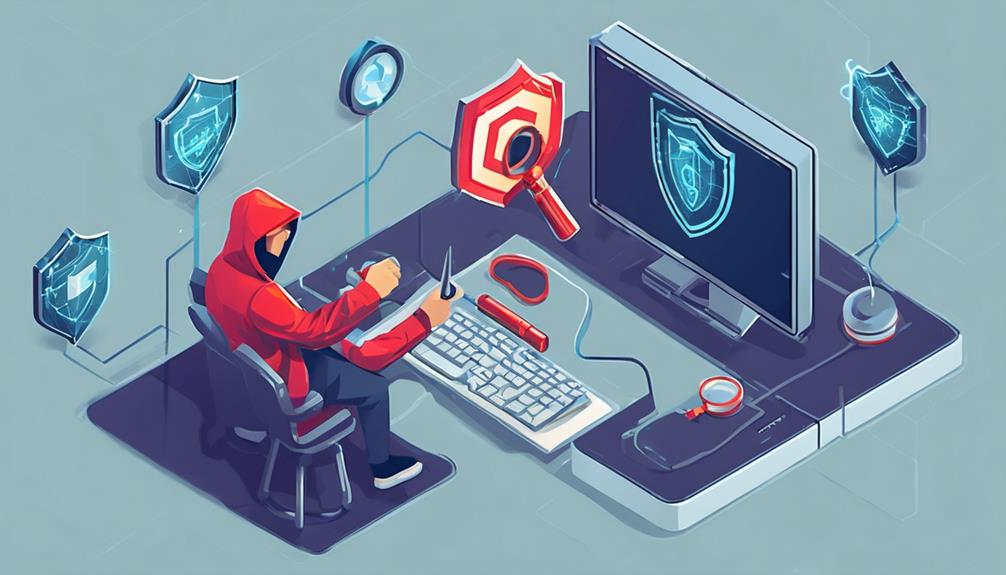
To effectively prevent sniffing attacks, organizations should implement encryption protocols like VPN or SSL/TLS to secure data transmission.
Educating employees about the risks of sniffing and enforcing network security measures are vital steps in safeguarding against unauthorized access.
Utilizing intrusion detection systems (IDS) and restricting physical access to network devices are additional strategies to defend against potential sniffing attempts.
Sniffer Detection Techniques
Implementing encryption protocols is an essential strategy to safeguard data from potential sniffing attacks, ensuring the secure transmission of information across networks. In addition to encryption, organizations can employ various techniques to detect and prevent sniffing incidents effectively. Monitoring network traffic for unusual patterns or unauthorized access is vital in detecting sniffing attempts early on. Intrusion Detection Systems (IDS) play a key role in alerting organizations to potential sniffing attacks by analyzing network behavior and identifying suspicious activities. Educating employees about the risks of sniffing and how to prevent it can also greatly enhance network security. Moreover, restricting physical access to network devices can prevent unauthorized individuals from conducting sniffing attacks. By implementing a combination of these strategies, organizations can strengthen their defenses against sniffing attacks and protect sensitive data from unauthorized interception.
```markdown
| Detection Technique | Description | Benefits |
|---|---|---|
| Network Traffic Monitoring | Observing data flows for anomalies and unauthorized access | Early detection of potential sniffing attempts |
| Intrusion Detection Systems | Automated monitoring tools that detect suspicious activities | Real-time alerts for potential sniffing attacks |
| Employee Education | Training employees on sniffing risks and prevention methods | Enhanced awareness leading to better security |
```
Network Security Measures
Utilizing robust network security measures is essential in safeguarding sensitive data from potential cyber threats such as sniffing attacks. Implementing encryption protocols like SSL/TLS can help protect data as it travels across networks, making it harder for sniffers to intercept and decipher information.
Network monitoring tools such as Wireshark play a vital role in detecting and analyzing suspicious network traffic, enabling timely responses to any potential security breaches.
Securing router configurations and monitoring router advertisements are fundamental steps in preventing IRDP spoofing, a common technique used by attackers to redirect network traffic. Additionally, mitigating Spanning Tree Protocol (STP) attacks can be achieved by employing security features like BPDU guard and loop guard, which help in maintaining the integrity of the network infrastructure.
To enhance network security further, tools like Omnipeek and Observer Analyzer can be utilized for thorough network analysis and monitoring, providing insights into network activity and potential vulnerabilities. By proactively implementing these measures, organizations can strengthen their data protection strategies and mitigate the risks posed by sniffing attacks.
Counter Sniffing Tools
Proactively incorporating counter sniffing tools is essential in bolstering network security against potential sniffing attacks. Sniffing tools like Wireshark play a vital role in detecting and preventing malicious attempts to intercept sensitive data across networks.
By implementing network monitoring tools, suspicious network traffic can be identified promptly, allowing for swift action to counter potential threats. Secure router configurations and monitoring router advertisements are vital to prevent IRDP spoofing, a common technique used by attackers to redirect network traffic unlawfully.
Additionally, employing security features such as BPDU guard and loop guard can help mitigate Spanning Tree Protocol (STP) attacks, further enhancing network resilience against malicious activities.
To secure DNS transactions and communication between servers, utilizing DNS SEC and SSL protocols is recommended. By integrating these countermeasures effectively, organizations can greatly enhance their network security posture and defend against various sniffing attacks effectively.
Common Sniffing Attacks

Common sniffing attacks target various protocols such as Telnet, HTTP, POP, IMAP, SMTP, and FTP. These attacks exploit the nature of clear text protocols, making data easily accessible to malicious actors monitoring network traffic.
By placing network interface cards (NIC cards) in promiscuous mode, hackers can capture data packets without being detected, allowing for unauthorized access to sensitive information. Passive sniffing involves silently monitoring data transmissions, while active techniques like Address Resolution Protocol (ARP) poisoning and Media Access Control (MAC) flooding can manipulate network traffic to intercept data.
ARP poisoning, for instance, tricks devices into sending data through the attacker's machine, enabling them to eavesdrop on the communication. Understanding these common sniffing attacks is crucial for implementing effective defense strategies and safeguarding against potential security breaches in various network protocols.
Defending Against Sniffers

To defend against sniffers effectively, organizations should prioritize implementing encryption protocols like VPN or SSL/TLS to secure sensitive data from potential interception. These protocols encrypt data, making it tough for malicious actors to eavesdrop on network communications. Additionally, using switches instead of hubs for traffic segregation can prevent unauthorized access to network data, adding an extra layer of defense against sniffing attacks.
Educating employees on the risks of sniffing and how to prevent it is vital for enhancing overall network security. By raising awareness and promoting best practices, organizations can empower their staff to recognize and report suspicious activities promptly.
Regularly monitoring network traffic for any anomalies or suspicious patterns is essential to detect and prevent potential sniffing attempts. This proactive approach allows for timely intervention before sensitive data is compromised. Moreover, utilizing intrusion detection systems (IDS) can provide real-time alerts about potential sniffing attacks, enabling organizations to take necessary preventive actions swiftly.
Monitoring Tools
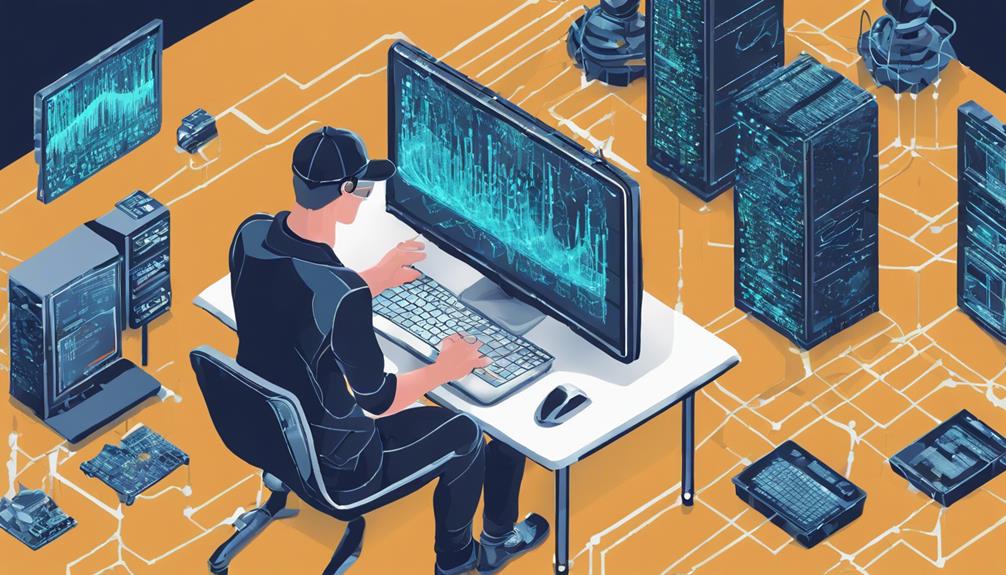
Organizations can enhance their network security by utilizing various monitoring tools to detect and analyze network traffic effectively. Wireshark, a widely used hardware protocol analyzer, enables the capture and examination of network data. Additionally, SPAN ports on switches facilitate efficient monitoring of network traffic.
Tools such as Omnipeek, Observer Analyzer, and PRTG Network Monitor are instrumental in network monitoring and analysis, providing insights into network performance and potential security threats. SolarWinds is another valuable tool for packet inspection and conducting in-depth analysis of network traffic patterns.
Wireshark offers advanced features like filtering traffic based on TCP ports and IP addresses, allowing for targeted monitoring and analysis. This capability enables organizations to identify and address potential vulnerabilities or suspicious activities within their network. By leveraging these monitoring tools effectively, businesses can strengthen their network security posture, proactively detect anomalies, and mitigate potential risks before they escalate.
Hands-On Experience
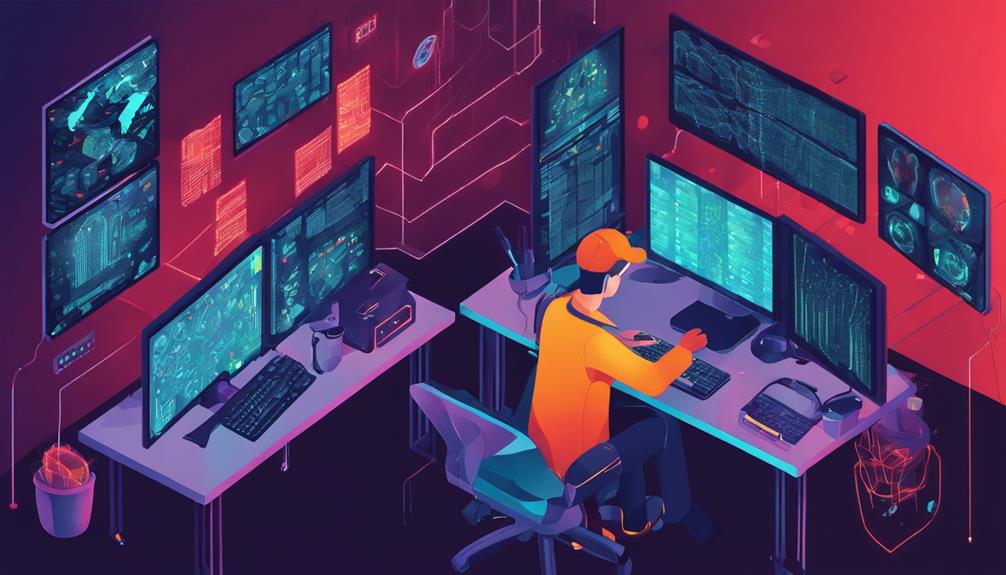
Practical application of network monitoring tools and software is essential for gaining hands-on experience in detecting and analyzing network traffic effectively. By utilizing hardware protocol analyzers like Wireshark, individuals can capture and scrutinize network data to identify any suspicious activities.
Understanding how to leverage SPAN ports on switches enables the monitoring of network traffic in real-time, allowing for the detection of potential sniffing attempts.
Moreover, practicing with tools such as Omnipeek, Observer Analyzer, and PRTG Network Monitor enhances one's proficiency in network traffic analysis. These tools provide valuable insights into packet inspection and analysis, important for identifying and mitigating sniffing attacks.
Software like SolarWinds can further aid in the identification of malicious sniffing activities, empowering individuals to counteract such security threats effectively.
Developing skills in deep packet inspection and real-time traffic analysis using tools like Wireshark, Observer Analyzer, and Omnipeek is fundamental in strengthening one's ability to detect and defend against various forms of network intrusion.
Ethical Hacking Skills

Understanding and mastering ethical hacking skills involves a thorough grasp of network vulnerabilities and the utilization of various techniques to evaluate and enhance security measures. The Certified Ethical Hacker v12 certification covers essential topics such as sniffing tools, MAC attacks, DHCP, ARP, and DNS. These skills are vital for IT security professionals to identify and defend against network attacks effectively. Ethical hacking training also emphasizes the importance of network traffic analysis, a skill that enables professionals to monitor and analyze network data for potential threats.
In today's cybersecurity landscape, the techniques used to detect and prevent network vulnerabilities continue to evolve. Ethical hackers rely on advanced sniffing tools to intercept and analyze network traffic, allowing them to uncover potential security weaknesses.
Additionally, ethical hacking courses like the one on Ethical Hacking: Sniffers teach practical countermeasures to mitigate the risks posed by network attacks, equipping professionals with the knowledge and skills needed to safeguard critical systems and data.
Frequently Asked Questions
What Is the Hardest Ethical Hacking Course?
The hardest ethical hacking course is the Certified Ethical Hacker (CEH) certification. It requires mastering advanced hacking techniques and defensive strategies. CEH exam #312-50 by EC-Council is known for its challenging scenarios and real-world simulations.
What Is Sniffer in Ethical Hacking?
In ethical hacking, a sniffer is a tool that intercepts and analyzes data packets on a network. It helps identify vulnerabilities by capturing sensitive information like passwords. Understanding sniffers is essential for detecting and defending against network attacks.
Is Packet Sniffing Legal?
Packet sniffing legality depends on consent and purpose. When authorized for troubleshooting or security assessments, it's legal. Unauthorized use violates privacy laws. Ethical hackers and companies use it with legal compliance to enhance network security.
What Are the Three Types of Scanning in Ethical Hacking?
In ethical hacking, the three types of scanning include port scanning, network scanning, and vulnerability scanning. Port scanning identifies open ports for potential exploitation, network scanning discovers active hosts and services, and vulnerability scanning uncovers weaknesses in systems.
Conclusion
To sum up, ethical hacking plays a vital role in safeguarding sensitive information from malicious actors.
According to recent studies, 60% of data breaches are the result of unauthorized access through sniffing techniques.
By learning to detect and defend against these attacks, individuals can enhance their cybersecurity skills and protect valuable data.
Taking a course on sniffers can provide practical knowledge and hands-on experience to help prevent cyber threats in the digital age.






